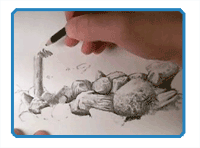
By Matt Fussell
Adding rocks in a landscape drawing or painting can create dynamic focal points. Rocks can also create contrast in texture and create the illusion of space in an image. The process of drawing rocks is similar to drawing anything else. It requires looking at the subject, understanding what you see, and then putting that information on the drawing surface. However, there is something that we can do when drawing rocks to help us get accurate forms.
Rocks can be simplified down into simple shapes. The shapes of most rocks can be created using simple geometric shapes like circles, triangles, and squares. These simple geometric shapes can be slightly altered to form the more organic shapes of most rocks. Once the shape of the rock is determined, the illusion of form can be created.
The illusion of form is created by adjusting values and creating a light source. One side of the rock will need to be lighter in value while the other will be darker. To create texture, abrupt changes in value will read as a rough surface, while smooth gradations in value will read as a smoother surface. It is important to consider the directional marks that are made with the material applied. These subtle marks, known as cross contour lines, will further the illusion of form and aid in the illusion of surface texture. Different rocks have different surface textures. It is important to pay special attention to what surface texture is observed, and make adjustments as the material is applied.
The following video features excerpts of a 1 hour live lesson that aired for members on this site on drawing rocks. To become a member, and gain access to members only videos, courses, and live lessons, visit thevirtualinstructor.com/member
Here are some more art lessons that you may like...
How to Draw Rocks
How to Draw a Tree From Imagination
How to Draw Trees